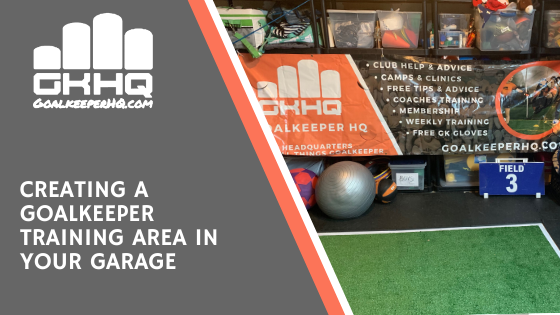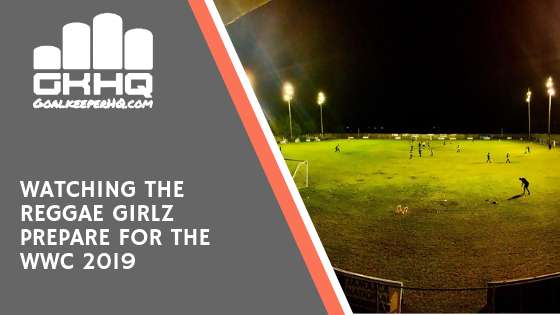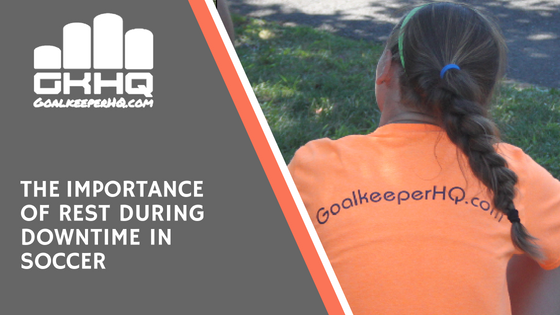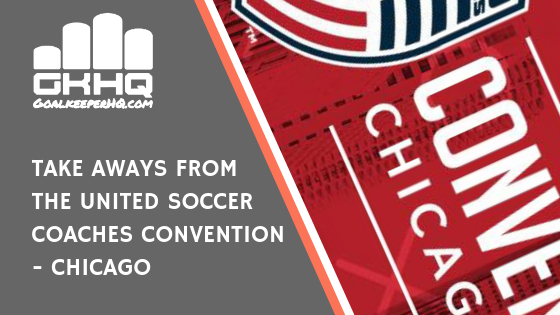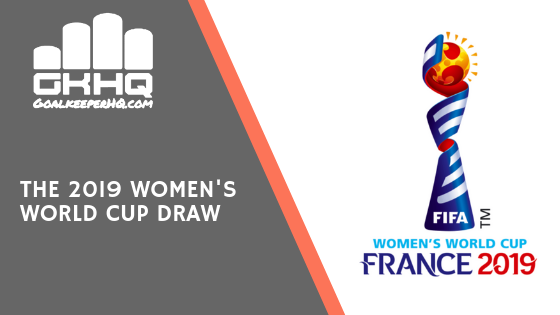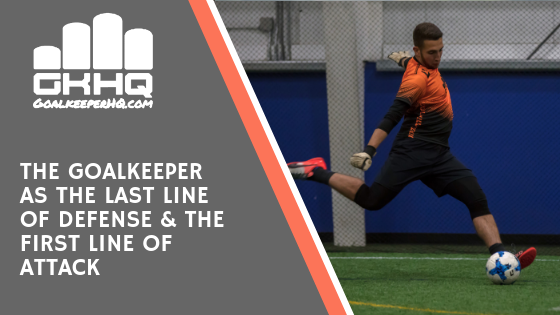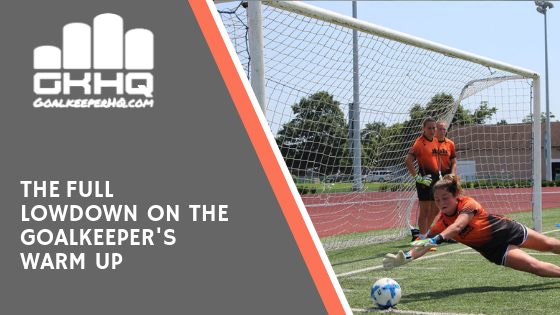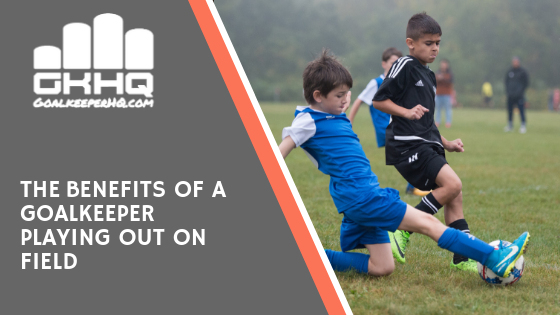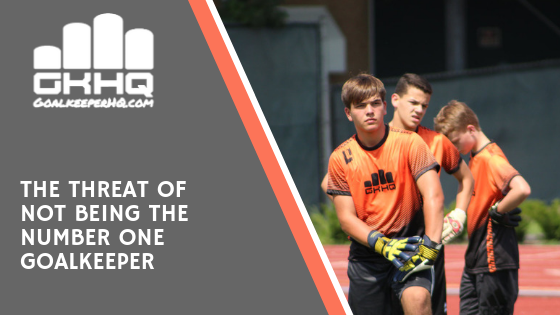Goalkeeper HQ
Your headquarters for all things goalkeeping
Author: Leon (page 1 of 16)
Through necessity and stay at home orders, goalkeepers have had to find creative ways to train and stay sharp. For those of you that have read the article [The perfect training area in your own back yard], you may have recreated something similar and gained an edge.
The inspiration I got for creating a training area in the garage of my house came purely by accident. I was due to provide a live virtual session to a group of players in my back yard when it started to pour down with rain. – Oh no! Where could I go where I could be noisy, not break TVs and actually not have neighbors think I was an idiot yelling at a computer screen.
The session was a success. In the garage, I had the same amount of area as the participants had either in a basement or their garage or a patio. The area was also small enough that players can watch the coaching points, exercises, and hear feedback.
The mini arena has evolved over the weeks. Below, I’m sharing the different stages.
The different stages of the garage soccer area
- For my first session, which needed to be done quickly, I just took the cars out of the garage, cleared away any potential dangers such as sharp gardening tools! I put my computer on a table and ensured everyone could see me. Job done.
After the success of the first class, and after jumping around on concrete, I thought it might be best to get some sort of carpet. This would also cover up the oil stains on the floor. I looked up green carpet and turf and ended up getting 2 x 8x10ft green mats from Ocean State Job Lot.
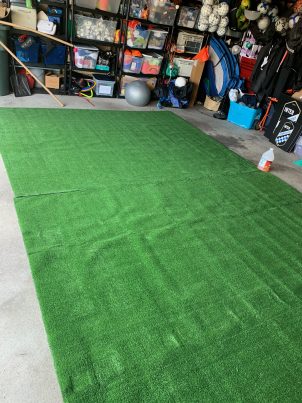
First attempt – Carpet down
Having done a session on the mats I was slipping so I used duck tape on the corners and on the underneath of the two mats to keep them together. I used cones on the corners to cover the tape.
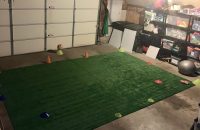
In order to get good educational video footage, I realized I needed two camera angles so I bought a mini phone tripod and had that filming from the side whilst the computer was in front.
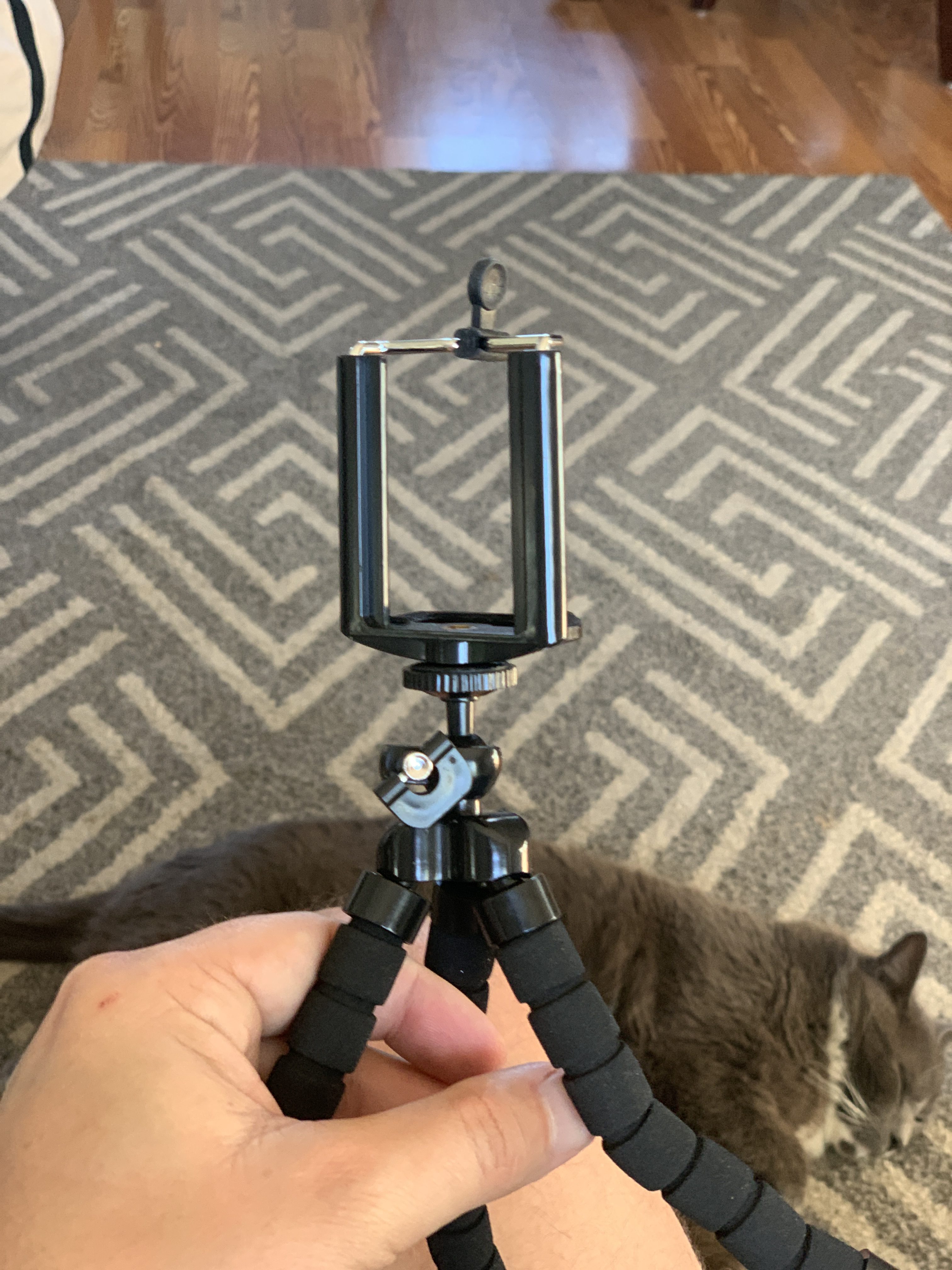
All good stadiums have advertising banners and I just so happened to have some laying around for Goalkeeper HQ and L1 Goalkeeper gloves so I put them up, if nothing else than to hide the random stuff that was on the shelves in the garage. This is certainly not a necessity but if players want to add posters or inspirational quotes that will help, go for it.
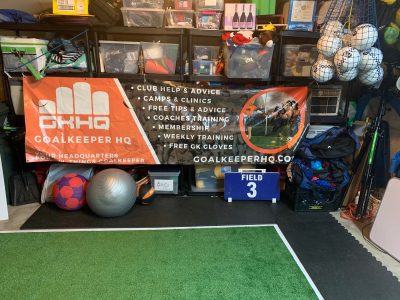
The purchase of white duck tape really added a nice finish to the edge of the carpet. It looks like painted lines that denote the edge of the field and provided a neat way to stop the carpet from moving during the sessions
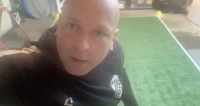
White Duck tape surrounding the carpet
In order to give good feedback to my students, I found I was kneeling down on the concrete floor, which was hurting my knee. I added a fitness mat that I had. This inspired me to create a Premier League style surrounding of the turf with a continuation of the mats along the side.
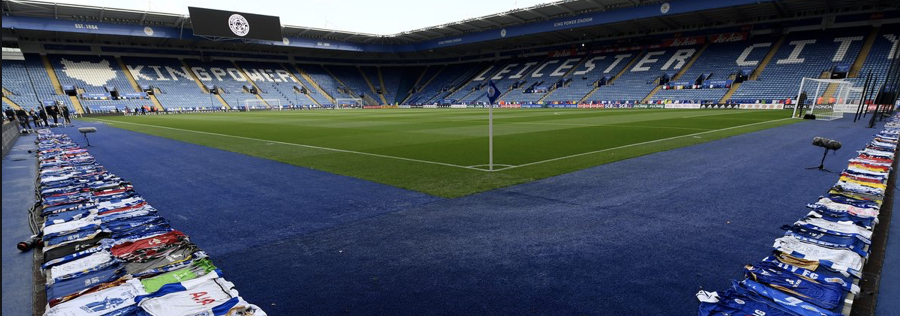
Equipment
When doing my videos, I have kept equipment to a minimum, knowing that students may not have access to everything. Here, though is a list of equipment that will help with all types of goalkeeping drills that don’t necessarily involve diving around like a crazy person.
- Cones
- At least two soccer balls
- Ladder
- Balance ball
- Strength bands
- Foam roller
- Rebounder

The garage soccer field or anything that you create in your own back yard can be used to get the additional training that is required for you to be the very best. This is the training that no one sees, but ultimately everyone will see the benefits.
The Goalkeeper HQ course – [The Goalkeeper in Isolation] provides session plans, videos, and ideas for goalkeepers to perfect as many of the goalkeeping core competencies as possible.
The Goalkeeper in isolation course is one of an 18 course bundle which is part of the [Goalkeeper HQ Membership program] which also includes a free pair of L1 Goalkeeper Gloves.
In January, Coach Marty and I were lucky enough to be invited to Jamaica to watch the Jamaican Women’s Soccer team, the “Reggae Girlz”, prepare for their first ever World Cup which is taking place in France in June this year ( 2019 ). We got to meet the goalkeeper coach and the goalkeepers during the first of the team’s training camps.
The Reggae Girlz created history by being the first Carribean team to qualify for the World Cup when they beat Panama on penalties back in October.
See just the Penalty Shoot out here where Nicole McClure helps the team qualify
The January training camp was held in a different part of the country from the normal national training center as the cultural ministry was keen to showcase the team on another part of the country.
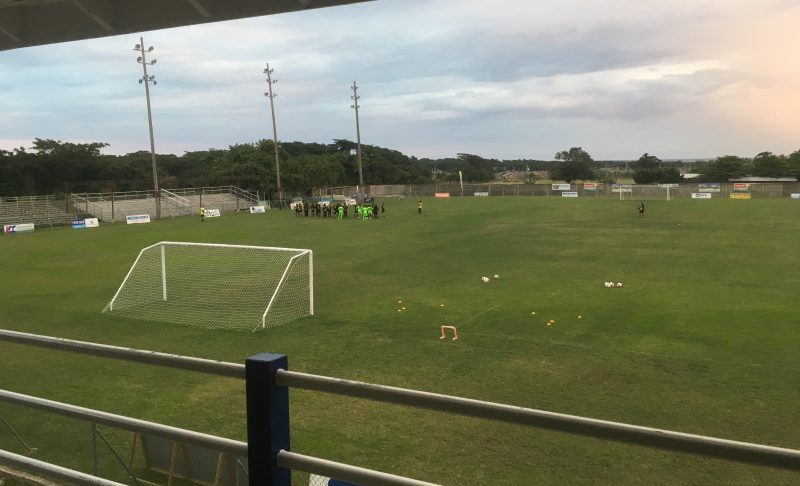
Draz Hall, the venue for team practices for the January camp
The players consisted of players playing in the USA, Europe and locally with competition being fierce for places with the prize of being in the final squad going to France up for grabs. The coaching staff, who came from Jamaica, Florida, Colorado, and Canada, has to find a balancing act of rewarding the players that got them qualified with integrating new talent that has been identified since the qualification. The set up was professional with the following staff members.
- Head coach
- Assistant coach
- Fitness, strength, and conditioning
- Goalkeeper coach
- Medical staff
- Video analysis staff
- Logistics
Double Sessions
The training camp resembled a college Preseason with training twice per day and other commitments such as team meetings and media added on top.
Day 1:
Highlights from Day 1 here:
https://www.facebook.com/reggaegirlz/videos/340671489857518/
Day 2:
AM – Drax Hall for 1) Warm up 2) Bleep test 3) Possession drills / Goalkeepers handling and footwork
PM – FIFA Banned substances seminar
PPM – Outfield = Opened up play, Goalkeeper = Diving followed by small-sided games going across the field.
Footage of sessions:
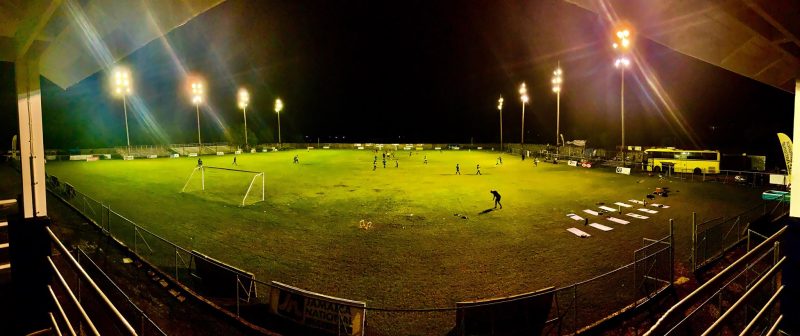
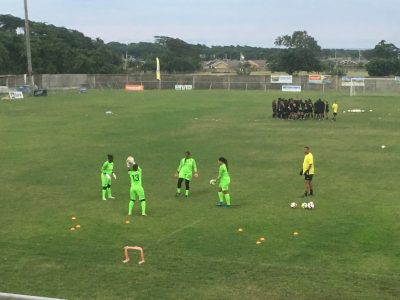
The take – away I saw was:
- Coach’s demand of good service from volleys
- Intensity required to impress.
- Variety of footwork movements for different saves.
- These girls can ping a ball!!
Day 3:
AM – Marty & I met with a local youth Academy to discuss the differences between youth soccer in Jamaica, the US, and Europe and provided L1 Gloves.

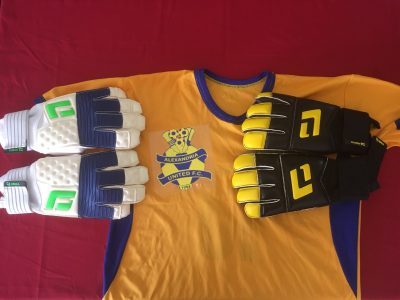
The evening saw the first inter-squad game being played at the Montego Bay sports complex.
Here are the highlights, with two goalkeepers starting and the other two coming on later.
Day 4:
We took our own advice and read the following important article:
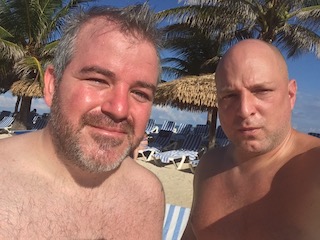
[The importance of rest during downtime]
The training camp involved much more than onfield bonding ( 8 new players discovered they had Jamaican roots once the team had Qualified for France ). Here is a list of their other commitments whilst at the 6-day training camp.
- Educated on banned substances and everyday items that contain them.
- Baseline fitness testing.
- Press day in Kingston
- Visit a hospital in Montego Bay
- Question and answer at a school.
The training camp and pending World Cup appearance is proof that for the country, soccer is a vehicle to inspire, educate, mobilize and support the next generation of young female football players in Jamaica.
Here is another video from the Friday session & media day in Kingston where the Reggae Girlz trained on the national stadium field.
I attended the United Soccer Coaches Soccer convention in Chicago last week. It is always good to catch up with some old work colleagues but also to really educate myself on the latest goalkeeping trends. Here are the goalkeeping notes from the United Soccer Coaches Convention in Chicago.
Here are the field sessions or classroom sessions I attended.
- Maximizing your Goalkeeper Training Environment – Phil Wheddon
- Methods to Lead a Team – Tim Bradbury
- Integration of Goalkeeper into Team Tactic/individual, Group and teamwork – Boris Kubla
- Modern Day Trends of Pro & College Goalkeepers – Jill Loyden
- The Team Warms up the Goalkeeper – Dan Gaspar
- Confidence v Competence: A Guide to how managing mood impacts performance – Marty Walker
In my take away trends from last years convention, I provide figures on how the goalkeeper’s job is different from 20 years ago and how the role of the goalkeeper has evolved in the last five years as the game changes.
- This year there was again the emphasis on the goalkeeper using their feet.
- Distribution should be seen in two ways. 1) To clear under pressure 2) To start an attack
- Good use of the non-dominant foot provides so much more freedom to become the first line of attack.
- The goalkeeper should have an identity. Something that they are known to do well.
- We should recognize that the goalkeeper’s identity may not suit the team’s style of play. As a goalkeeper are you aware of the team’s style of play and can you adapt to it?
- As coaches, we should be aware that a goalkeeper may look competent at one level but may struggle at a higher level. The pace of the ball, speed of play, ability to get shots off quicker, adding curl all change, the higher the level you play.
- Distribution success should not be counted as getting the ball to your own teammate, but if the player you pass to can get their pass off successfully. (Therefore giving more emphasis on the quality of the goalkeeper’s distribution, the communication and the need to think about higher level details such as what side pressure is coming from)
- In the female college & pro game, most action for goalkeepers is from flank service & shots from distance
- 93% of goals conceded, however, were from inside the box.
- I got some ideas to incorporate the goalkeeper into team warm-ups, which I will share in another article.
- Lastly, it is a player’s mood prior to a game that affects performance more so than any competency or confidence. What do you do as a player, parent or coach to improve your mood.
As a reminder of last years takeaways, here are the notes from last year.
TAKE AWAY NOTES FROM UNITED SOCCER COACHES CONVENTION, PHILADELPHIA 2018
As we preach at Goalkeeper HQ, it was stated that the modern day goalkeeper’s job is different from 20 years ago and it can be argued that the goalkeeper’s job has changed in the last five years or so. This is because the game itself is evolving.
There is now an attacking trend in the game, which lends itself to playing three defenders at the back or even if there are four in the formation, there are often attacking full backs which are encouraged to get high up the field.
Below is a diagram of what the average game looks like for a college goalkeeper playing 90 minutes.

- Goalkeeper has possession of the ball for just 4 minutes
- 18% of the game is the bits most people associate with goalkeeping – Catches, saves & punches
- 82% is distribution related – More than when I wrote an article called Back Pass – Facts“
On average, the goalkeeper is expected to make 2.6 saves per game & around 30 passes. The key is to ensure the 2.6 saves are saves and not goals and that as many of those 30 passes are as accurate as possible.
THERE ARE THREE TRENDS IN THE MODERN GAME ARE MOST COMMON
1 – An increased importance of distribution
2 – The ability to deal with quick transitions, both denying the opposition and also setting up a quick transition for your team
3 – Crosses are now rarely floated into the box. They are now whipped in quicker to “Second 6yd box” between 6yd box and the penalty spot or pulled back.
THE GOALKEEPER’S STRENGTHS / WEAKNESSES, AS WELL AS THE TEAMS, SHOULD BE CONSIDERED IN A STYLE OF PLAY. BOTH ATTACKING AND DEFENDING.
Here are some examples:
- A fast team, looking to counter-attack requiring the goalkeeper to distribute quickly beyond the oppositions back line.
- A team that builds from the back requires a goalkeeper comfortable to play from the back accurately and provide a number of different ranges
- A goalkeeper who is comfortable playing high will enable the team to go with three at the back.
It is often easier for the coach to change the goalkeeper to fit the needs of the team style than for the coach to adopt a style that is best for the goalkeeper
THE AVERAGE POSITIONING FOR A SAVE MADE BY A GOALKEEPER IN THE PREMIER LEAGUE IS THREE YARDS OUT
With the trend to now whip in fast, low crosses or to pull the ball back, goalkeepers are tending to drop further back and provide more reaction time than to step up and narrow the angle. New balls provide a higher velocity and more movement requiring this reaction time.
Goalkeepers are now taller, and more athletic which enables them to block more of the goal when they are set and have enough reaction time. In fact, goalkeepers are required to be amongst the top athletes on the team.
DUKE GOALKEEPER ( Male )
Height / Weight – 6′ / 180lb
Vertical Jump – 32″ (Ranked #3 on team)
Broad Jump – 9′ (Ranked #3 on team)
40yd dash – 4.8secs (Ranked #5 on team)
PENN STATE GOALKEEPER ( Female )
Height / Weight – 5’11 / 145lb
Vertical Jump – College improvement = 7.5″ (Ranked #1 on team)
Broad Jump – College improvement = 11″ (Ranked #1 on team)
40yd dash – College improvement = .2secs (Ranked #3 on team)
IT IS OUR JOB AS GOALKEEPER COACHES TO BEST PREPARE GOALKEEPER FOR THE GAME.
There are differences in the demands of each stage of goalkeeper development. It is our job as goalkeeper coaches to make sure that the goalkeeper understands what is expected of them and to also incorporate the relevant aspects of each theme of goalkeeping.
- Servers should be hitting moving balls as that’s what happens in games
- Goalkeepers should face a variety of servers for the same practice or drill to get used to adjusting to different speeds and trajectories of the ball that different servers bring
- After saves are made, a transition should be incorporated in the release of the ball
- A backpass scenario can be provided prior to most saves
DESPITE OUR SPECIALIST TRAINING, IT IS IMPORTANT FOR GOALKEEPERS TO BE INCORPORATED INTO TEAM PLAY
As stated above, a team may have to adopt a style based on their strengths. It is important that the team know the goalkeeper’s strengths and weaknesses so they can better deal with them.
It is just as important for the goalkeeper to know the team’s strengths and weaknesses. It may be that the goalkeeper works out that the left back always cuts in because they are right footed. It might be that one central defender is more comfortable with the ball at their feet than the other.
The goalkeeper should use time with the team to get to gel in a relationship.
For any questions on the above, please do not hesitate to reach out. Leon@GoalkeeperHQ.com
Tournament hosts France will open the 2019 FIFA Women’s World Cup against South Korea on June 7 after the group-stage bracket for next summer’s competition was announced at La Seine Musicale, Paris, on Saturday.
They’ll be paired up with Norway and Nigera as well to form Group A, where Les Bleues can have high hopes of advancing as winners.
Titleholders the United States will meet Sweden in the group stage for the sixth consecutive World Cup, meanwhile, and find themselves opposite Chile and Thailand in Group F.
England, meanwhile, will meet 2015 runners-up Japan in Group D, as well as home nation rivals Scotland and Argentina.
New Zealand recently became the 24th and final country to qualify for the tournament, when they beat Fiji 8-0 to lift the 2018 OFC Women’s Nations Cup, and are looking to progress past the group stage for the first time.
FIFA provided a breakdown of the six groups in full:
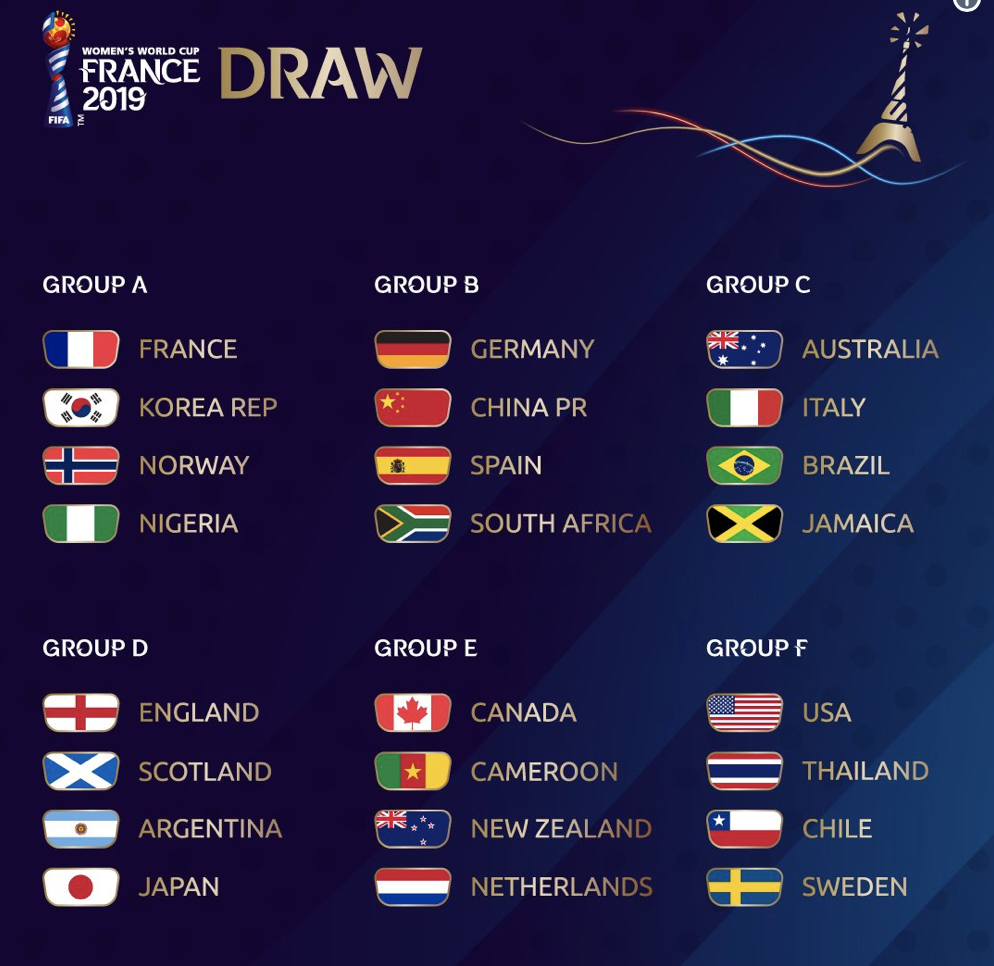
France will host the World Cup for the first time in its eighth edition; this will also be the third time a European nation has hosted after Sweden in 1995 and Germany in 2011.
Les Bleues will be eager to beat their previous-best run to fourth in the 2011 tournament and are in good form under coach Corinne Diacre, having won their last seven matches in succession. Their men’s team became world champions in 2018, and they’ll hope to follow suit by winning the final on July 7.
Being the Goalkeeping Director for Everton FC’s USA affiliate, Everton America, I take a keen interest on the actions of first team goalkeeper, Jordan Pickford’s performances.
Pickford’s rise to the being first choice for the England team has been a great inspiration for goalkeepers, especially those that are not blessed with multiple inches over 6ft. The last minute goal he conceded against Liverpool, however, will not be one of his proudest moments.
How the goal unfolded.
In the last play of the Liverpool v Everton derby, Liverpool pumped forward a long ball which was headed out to Virgil van Dijk. The Liverpool centre-half attempted a volley at goal but flubbed it and it span high upwards into the sky. The Dutchman even turned away in disgust at his strike. Read more: Liverpool’s win over Everton one that could go down in folklore… if they can keep pace with Man City But the ball kept falling, down towards Pickford’s goal. The goalkeeper went to catch it, and did, but his wrists hit the bar. The ball, which hadn’t crossed the line, tipped out of his hands and up into the air, back down onto the bar, and out to Origi.
See the goal here:
The unusual spin of the ball generated by the miss kick led to that horrible ball that you have to deal with but if you don’t get your decisions correct, it leads to a mishap.
Things that will be going through the goalkeepers mind in what must have seemed an eternity whilst the ball was spinning in the air.
- What is the trajectory of the ball? Is it going over the bar? Will I have to deal with it?
- I need to get underneath the ball and ensure good body shape. Will I bang into the post? Are players running at me?
- Do I catch the ball or tip it over? If I tip it over, I’ll give away a last minute corner.
- I’m not the tallest of goalkeepers, I have great spring though and can prove it. Once I catch, who can I distribute to?
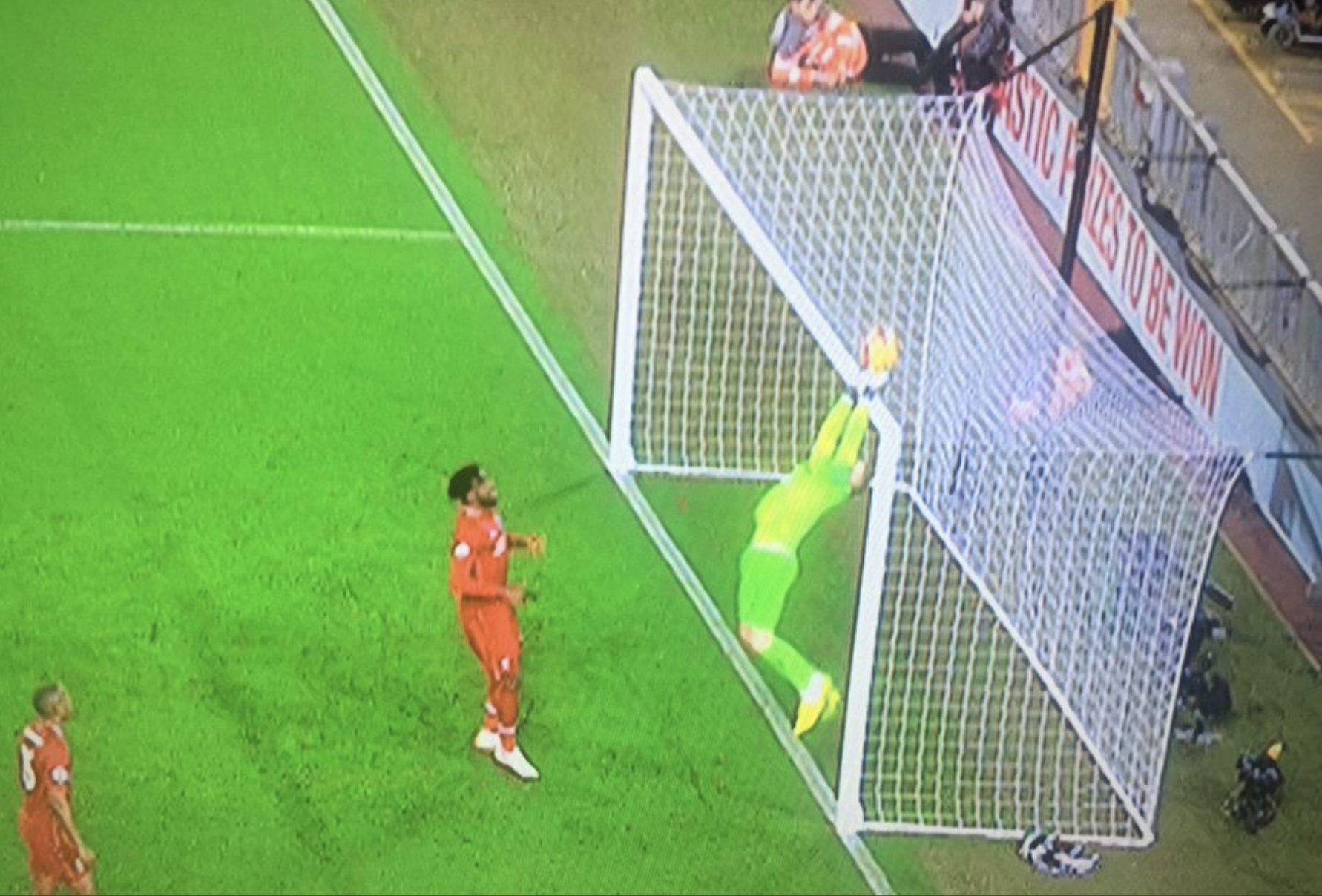 In a post game Interview, Pickford explained the following.
In a post game Interview, Pickford explained the following.
The 24-year-old confirmed that he was trying to tip the ball over the bar rather than catch it, though mis-controlled when his hands hit the crossbar. “It was a freak one, really. It had hit the bar twice and I tried to flick it over,” he said. “The ball spun and as I tried to flick it over, my hand hit the bar.”
It sounds like Pickford made the decision to tip, rather than what most people originally thought, which was that he tried to catch it. If this is the case, the technique of tipping needs to be brought up.
When tipping a shot over or around the post, generally the pace of the shot is enough so that when you get your fingers on the ball ( To tip, as opposed to parry ) it is enough to change direction of the ball whilst still having enough momentum to get the ball over the crossbar or around the post and out of play. This is why the “top hand save” can be so effective. I often see goalkeepers try to flick the ball over the bar with an intricate twist of the wrist and extension of fingers with disastrous results. Keep it simple and use the pace of the ball with a flat hand to tip.
See example of using the pace of the ball to tip
With that being said, if the ball does not have the pace required due to spin, as in the case of the Liverpool goal or a deflection, a flick may be required. See this England drill which requires the goalkeepers to get a flick on the tip to get it over the bar or wide.
If the ball is close to the crossbar, the goalkeeper may have to do the counter intuitive action of turning the hand and body toward the goal to flick the ball over the bar. After hours searching the internet, the best example I can find is this Peter Schmeicel one below.
This technique would have been best used for Pickford for the goal as the ball was both spinning with no speed, and was close to the crossbar.
There has not been much mention in the newspapers though that not one Everton defender was on hand to help with rebounds or shield runners. ( See below )
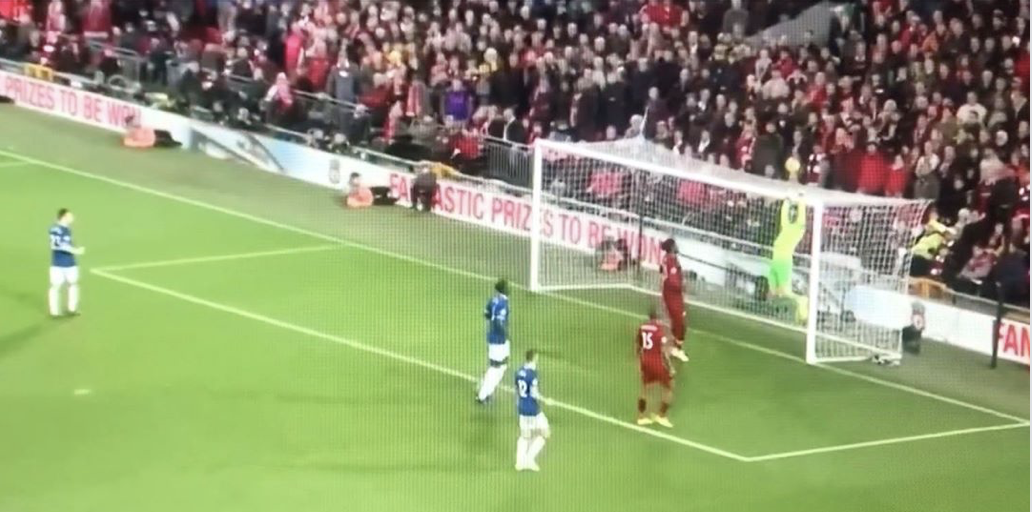
What can we learn from this goal?
- Take nothing for granted. I mis hit shot may well require action and the goalkeeper should deal with it.
- Once you have assessed the shot / cross, a decision needs to be made to catch, tip or parry the ball.
- When tipping a shot, the speed / trajectory of the shot or cross determines if you use a flat palm facing the field, or if you turn your hand / body to flick the ball over the bar.
- Defenders need to be aware of difficulties goalkeepers face and provide both information and support.
- Pickford, though disappointed kept his cool with a simple apology.
- The goal came from the foresight of the Liverpool goalkeeper, Alison to take the free kick short so that Trent Alexander-Arnold could get a better angle and get closer when kicking the ball forward for the last gasp attempt.
After watching England play Spain in the new UEFA Nations League game in which Jordan Pickford helped to create two goals with his great distribution, I thought I would highlight how the goalkeeper is not only the last line of defense, but also the first line of attack.
Video 1 – England’s first goal v Spain
Video 2 – England’s second goal v Spain
Video 3 – Belguim’s goal v Japan
For another related article, please see [The Goalkeeper as the Quarterback of the Team]
As a goalkeeper, you need to prepare both your mind and body before a game. You have to be confident that you are in the best possible shape to play.
The goalkeeper’s warm-up should be different from that of an outfield player and should ideally consist of four elements.
Psychological
The first and most important thing is the goalkeeper is in a confident and in a relaxed state. This can be obtained through positive reinforcement and putting him or her in situations where they will achieve success.
Physical
The body has to be ready to perform the movements required of a high-level goalkeeper (footwork, movements, contact with the ground and contact with other players).
Technical
It is important to go through a variety of technical aspects of goalkeeping that will be used in a game.
Game related situations
This has to do with either a scouting report on how your team or the other team play, the type of surface you are playing on, dealing with conditions and the balls that you are playing with.
The Psychological & Game related situations can be incorporated into the Physical and Technical. Below I will address each.
Physical – Preparing the body for optimum performance
A significant amount of research has shown that performing a proper dynamic warm-up before an activity is a much better route to optimizing performance than simply static stretching. A proper dynamic warm-up has many physiological benefits:
- Increases core body temperature
- Increase blood flow to the muscles
- Stimulates the nervous system and activates muscle groups
- Improves joint mobility and flexibility
- Increases coordination and balance
- Reinforces proper movement patterns
- Decreases risk of injury (due to all of the above mentioned)
There are four parts to this specific category.
- Pre-activation. First, we want to get your stabilizer muscles firing. This includes activating the smaller core muscles surrounding your torso. This is because we all have muscle imbalances and by going straight into exercises, you automatically work your stronger muscles thus creating more of an imbalance.
Examples of preactivation suitable for goalkeeper warm up.
- Balance drills
2. Mobility / Flexibility exercises. These are exercises geared towards improving range of motion and raising the heartbeat
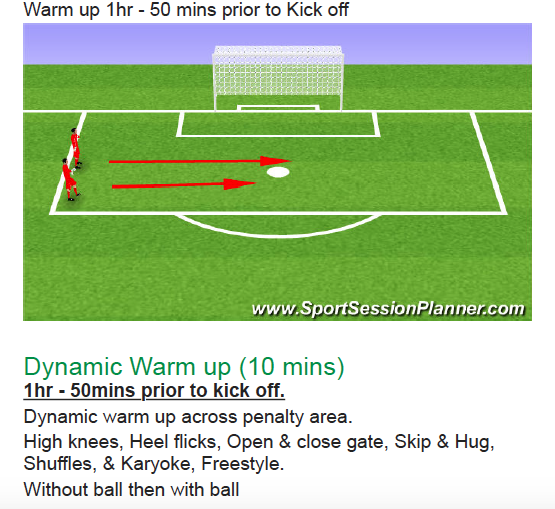
Examples of mobility /flexibility exercises suitable for goalkeeper warm up.
- High kicks
- Open / Close the gate
- Arm circles
See this video of Courtois doing mobility and flexibility exercises as he enters the field.
3. Moving stretches. This can be done with a ball and coupled with handling.
Examples of moving stretches include
- Backward reaches
- Lunges
- Inchworms
4. Build up & Load acceptance Now it is time to ramp it up if your planned activity involves power, speed, or agility drills to prepare for the game. This final step is preparing your nervous and muscular systems for higher speed, more complex athletic movements. This can certainly be incorporated into the Technical part or your warm up.
See this video of Courtois doing these type of exercises as the final part of his physical warm up.
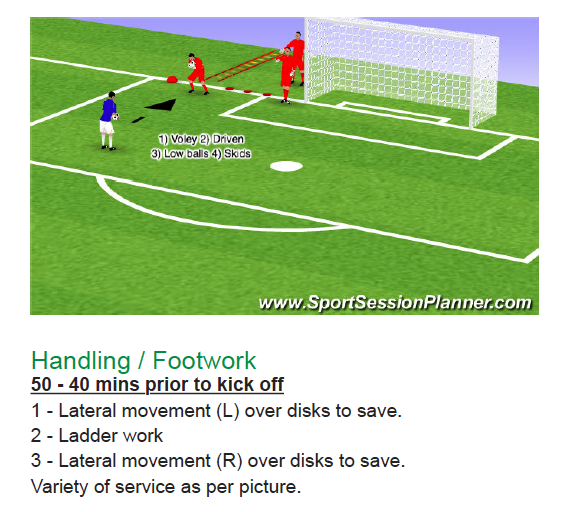
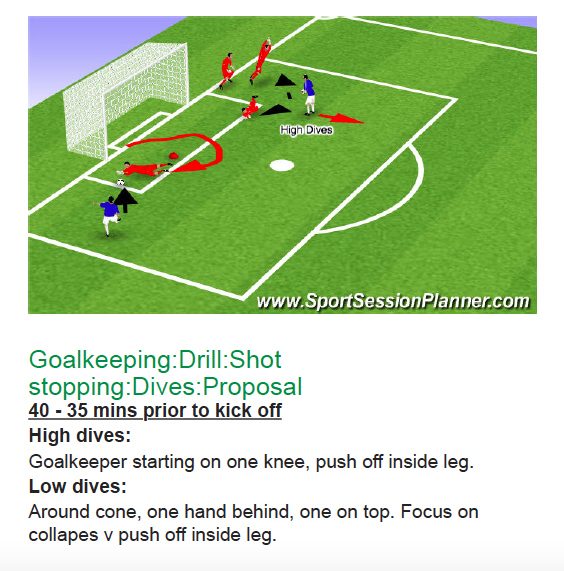
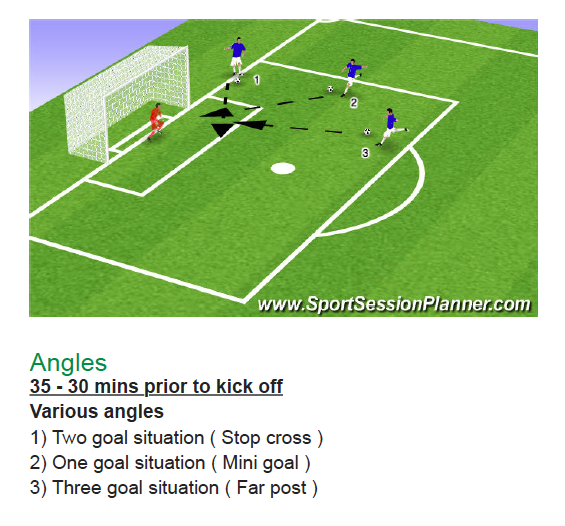
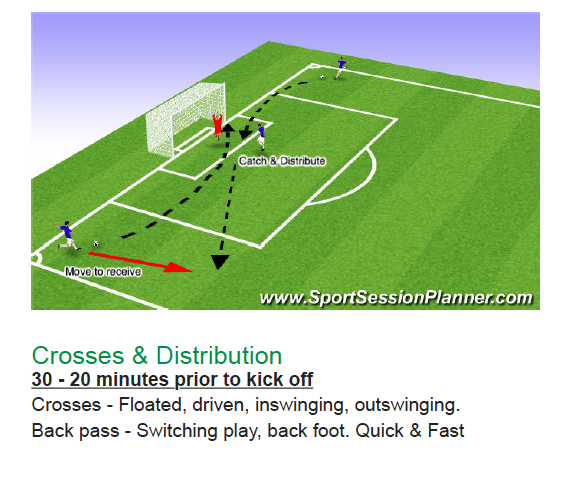
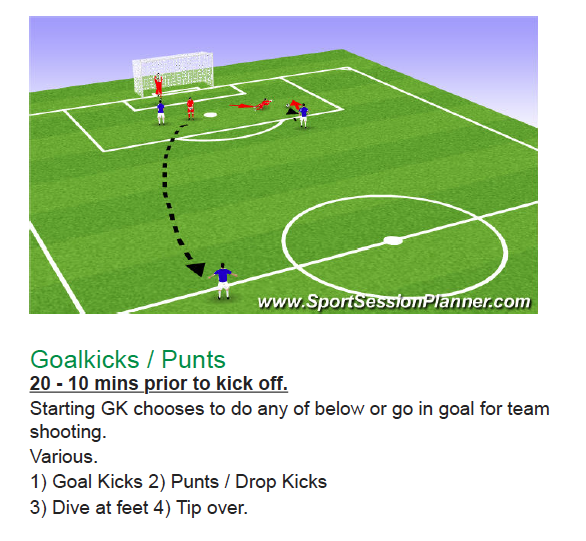
Psychological
The Psychological aspects needed will be reinforced through completing clean saves, or finishing on good saves, having the GK coach or other GK reinforce good technique. Service would have been hard, but not impossible and sufficient rest in between technical exercises.
The goalkeeper should also be conscious that much of the aim of shooting practice is to give strikers confidence. The goalkeeper should maybe go in for a few shots to get a feel for the speed in which shots may come in and improve reactions, but should certainly not get down if shots go in. The backup goalkeeper should field the remainder of these shots.
Game related situations
During the technical warm-up, you would have dealt with some of the natural conditions. Wet surfaces and skidding balls, turf, grass, mud, wind, sun or ice.
It is important that you request one or two match balls to practice with ( If the team you are playing against has them) to get a feel. In my experience, different brands of ball feel bigger or move differently in the air.
During the warm-up, you should have got an understanding of how the area and the goalmouth play before you kick off. Make sure between you and the server you really understand how the ball rolls when hit across the ground, how does it bounce? This can often vary drastically between in and outside of the 6-yard box so really do test it out and adjust your play style accordingly if needed.
If a scouting report shows that the opposition prefers to do something, in particular, some additional time may be spent on that in the warm-up. We must realize, however, that the game warm-up should not be confused for a practice session.
Inspired by a question on the Goalkeeper HQ closed facebook group and something that is occuring more so in youth soccer. The goalkeeper playing out on field when not in goal.
Here is the question that was posted;
“What do you do when your child has been a keeper since they were 9 years old and you get a new coach for high school who is splitting the keeper position but wants your child to play the field the other half. And during practice and scrimmages puts your child on the field to practice rather than in the other goal. Daughter is a junior and has every intention of playing college. Thoughts?”
I see there being two parts to this question.
- Dealing with the threat of not being the #1 Goalkeeper ( Linked article )
- The benefits of playing out on the field.
The benefits of playing out on the field.
We should all know that the game is evolving and that goalkeepers, amongst other things, are expected to play the ball out like an NFL Quarterback. See the article.
I will provide ( soon, I hope ) an article on how to be not just good, but great with your feet in another article, but for now, let’s look at the benefits of being asked to play on the field.
- Premier League stats show that although there has been an increase in the number of passes made by goalkeepers, year on year since 2012, the big increase in the number of goalkeepers being asked to make 800+ passes in a season. ( That’s 20+ per game ). By playing out on the field you will get an opportunity to get the much-needed practice in when passing the ball.
- The speed of decision making for the passes you make will improve as on the field, players are more likely to press you more quickly than when you are the furthest player back.
- Fitness is important for any athlete, and goalkeepers in the past have had a reputation of being lazy, just standing in the goal. Use this time out on the field to improve your cardiovascular fitness. Goalkeeping fitness is certainly different but the cardiovascular fitness you gain will be important for those high-intensity games and could make the difference between making a save and not making a save when you would otherwise be tired.
- Know your players better. As a goalkeeper, it is easy to be apart from the team as opposed to being part of the team. Use this time to muck in with the team, enjoy jokes and the camaraderie. Just as long as the jokes are not on you!
- Appreciate your friends. ie your defenders. By playing as a defender, you will have a better understanding of what a goalkeeper is asking of them. You will appreciate the balls that the goalkeeper expects defenders to get, you will how good/bad communication can affect decision making and you will be able to understand the ways in which defenders are likely to get beat and what that means for a goalkeepers positioning.
- Know your enemies! ie the forwards. Much like it is important to know how defenders react in certain situations, it important to get an insight into what it is like to play forward so that as a goalkeeper you are better prepared. Angles of shots, the likelihood of hitting shots first time, ways to beat a defender etc!
Many thanks to the Goalkeeper HQ community who helped answer this question with real-life answers. See below.
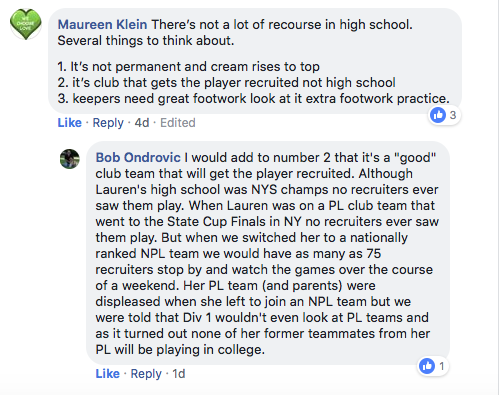
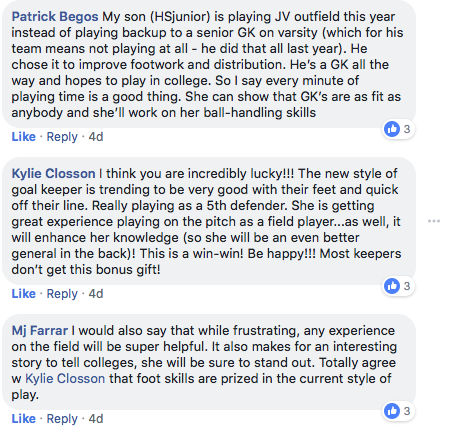
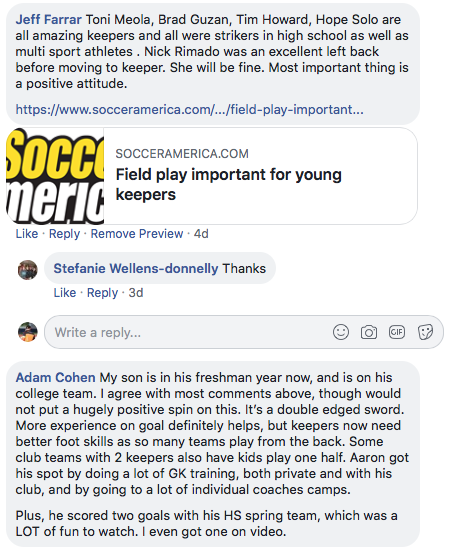
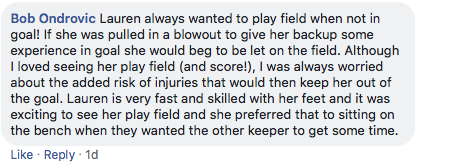
See part one of this article which answers the first part of the question – [Dealing with the threat of not being the #1 Goalkeeper]
The Goalkeeper HQ community is proving it’s worth with the website and social media platforms acting as a great resource. We recently got a great question which I wanted to share with everyone.
“What do you do when your child has been a keeper since they were 9 years old and you get a new coach for high school who is splitting the keeper position but wants your child to play the field the other half. And during practice and scrimmages puts your child on the field to practice rather than in the other goal. Daughter is a junior and has every intention of playing college. Thoughts?”
I see there being two parts to this question.
- Dealing with the threat of not being the #1 Goalkeeper
- The benefits of playing out on field
Dealing with the threat of not being the #1 Goalkeeper
There are pros and cons to having to deal with two goalkeepers on a team. In the article – “Best of friends, keenest of rivals – Dealing with being one of two goalkeepers” I list the benefits, which are;
- Create healthy competition
- For the goalkeepers to warm themselves up together
- Takes the pressure off of the goalkeeper if they have to miss a game
- It allows for recovery of injuries
- Two goalkeepers allow for an inter-team scrimmage.
With this being said, there is a psychological barrier to deal with when you feel you are losing your place as the starting goalkeeper. Confidence issues come to play and a feeling of rejection can arise.
As in another article that addresses “Dealing with getting dropped from the team” here are some reasons why you may be falling out of favor?
- Performance. You are making too many mistakes and you do not instill confidence in the team
- You have done something very wrong that breaks the club’s code of conduct. The coach needs to stamp authority on the team and prove that it is not ok to behave in that way
- Your head is not right! – You are distracted and focus is not as it should be. This often leads to distracting others in training and during games or not being responsive.
- Your strengths do not match the opposition or the way that coach wants you to play
- Persistent small infringements that undermine the coach. Turning up late, wearing the wrong uniform, talking when the coach is etc.
- Playing time needs to be given to another player in order to keep up the strength of the squad.
The same article also provides advice on dealing with some of the emotions if you do get dropped, but the original question does not imply that this has happened so here is advice for a healthy and competitive relationship with any goalkeepers looking to take your spot.
Here is some advice for goalkeepers who are competing for the number one spot.
1 – Do not make enemies with the other goalkeeper. Although they are competing with you for your place, you need them to push you harder, provide quality service, warm you up, provide you with rest during practice drills. A visual resentment towards the other goalkeeper will not go down well with the coach.
2 – Be coachable. The ability to take criticism without looking for an alibi. Not being a “Know it all”, and always looking to improve.
3 – Show that you love the game and the position. Is there a passion in the way that you train? Give 100% every time.
4 – Provide evidence of being mentally tough. Ensure that one mistake does not lead to a mental breakdown causing many more mistakes.
5 – Treat practice like you would a game. Demand great technique from yourself. Communicate with players like you would in a game.
6 – Practice at home. Even if it is small things like strength or speed training. Little improvements add up over time.
7 – Show that you are willing to make sacrifices. Are you available for selection during a friends birthday party – even if you don’t get to play?
8 – Look the part. Correct uniform, shoes tied up, shirt tucked in, socks pulled up – ball pumped up
9 – Befriend the influential players on the team. These are normally the loudest players or the captains. Other influential players are the defenders that play in front of you.
10 – Similar to #9, is the communication you give your defenders. If you just bellow out instructions or commands without any praise, the defenders will get sick of you. Boost their ego. Make them feel good with a “well done” – Defenders will like playing in front of goalkeepers that make them feel good. Coaches will pick up on that chemistry and elect to play you.
11 – Be ready to perform when called upon due to injury. See my post “Waiting in the wings”
For the second part of the question please see the article [ THE BENEFITS OF OUTFIELD TRAINING FOR GOALKEEPERS ]
